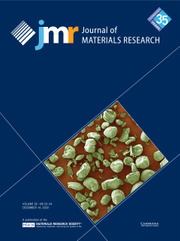Crossref Citations
This article has been cited by the following publications. This list is generated based on data provided by
Crossref.
Estreicher, Stefan K.
1995.
Hydrogen-related defects in crystalline semiconductors: a theorist's perspective.
Materials Science and Engineering: R: Reports,
Vol. 14,
Issue. 7-8,
p.
319.
Anderson, Alfred B.
Grantscharova, Emilia J.
and
Angus, John C.
1996.
Molecular-orbital theory of monatomic and diatomic substitutional defects as shallown-type dopants in diamond.
Physical Review B,
Vol. 54,
Issue. 20,
p.
14341.
von Kaenel, Y.
Stiegler, J.
Blank, E.
Chauvet, O.
Hellwig, Ch.
and
Plamann, K.
1996.
Microstructure Evolution and Defect Incorporation in Highly Oriented and Textured CVD Diamond Films.
Physica Status Solidi (a),
Vol. 154,
Issue. 1,
p.
219.
Connell, S.H.
Sideras-Haddad, E.
Smallman, C.G.
Sellschop, J.P.F.
Machi, I.Z.
and
Bharuth-Ram, K.
1996.
3D-microERDA microscopy of implanted H-distributions in diamond.
Nuclear Instruments and Methods in Physics Research Section B: Beam Interactions with Materials and Atoms,
Vol. 118,
Issue. 1-4,
p.
332.
Anderson, Alfred B.
and
Kostadinov, Lubomir N.
1997.
P and N compensation in diamond molecular orbital theory.
Journal of Applied Physics,
Vol. 81,
Issue. 1,
p.
264.
Machi, I.Z.
Connell, S.H.
Schaaff, P.
Doyle, B.P.
Maclear, R.D.
Bharuth-Ram, K.
Formenti, P.
and
Sellschop, J.P.F.
1997.
Hydrogen mobility in diamond studies using HI-ERDA microscopy.
Nuclear Instruments and Methods in Physics Research Section B: Beam Interactions with Materials and Atoms,
Vol. 127-128,
Issue. ,
p.
212.
Swain, Greg M.
Anderson, Alfred B.
and
Angus, John C.
1998.
Applications of Diamond Thin Films in Electrochemistry.
MRS Bulletin,
Vol. 23,
Issue. 9,
p.
56.
Martin, Heidi B.
Smith, Bridget A.
Angus, John C.
Landau, Uziel
and
Anderson, Alfred B.
1998.
Boron-Doped Diamond Films for Electrochemical Applications.
MRS Proceedings,
Vol. 555,
Issue. ,
Chevallier, J.
Theys, B.
Grattepain, C.
Deneuville, A.
and
Gheeraert, E.
1998.
Hydrogen Diffusion in Boron Doped Diamond: Evidence of Hydrogen-Boron Interactions.
MRS Proceedings,
Vol. 510,
Issue. ,
Chevallier, J.
Theys, B.
Lusson, A.
Grattepain, C.
Deneuville, A.
and
Gheeraert, E.
1998.
Hydrogen-boron interactions inp-type diamond.
Physical Review B,
Vol. 58,
Issue. 12,
p.
7966.
Connell, S.H.
Sellschop, J.P.F.
Butler, J.E.
Maclear, R.D.
Doyle, B.P.
and
Machi, I.Z.
1998.
A study of the mobility and trapping of minor hydrogen concentrations in diamond in three dimensions using quantitative ERDA microscopy.
Diamond and Related Materials,
Vol. 7,
Issue. 11-12,
p.
1714.
Sellschop, Friedel
and
Connell, Simon H.
1998.
“Carbon! … and its analysis”.
Nuclear Instruments and Methods in Physics Research Section B: Beam Interactions with Materials and Atoms,
Vol. 136-138,
Issue. ,
p.
1253.
Chevallier, J
Lusson, A
Theys, B
Deneuville, A
and
Gheeraert, E
1999.
Evidence of hydrogen–boron interactions in diamond from deuterium diffusion and infrared spectroscopy experiments.
Diamond and Related Materials,
Vol. 8,
Issue. 2-5,
p.
278.
Machi, I.Z.
Butler, J.E.
Connell, S.H.
Doyle, B.P.
Maclear, R.D.
Sellschop, J.P.F.
Sideras-Haddad, E.
and
Rebuli, D.B.
1999.
Diffusion characteristics of hydrogen in diamond.
Diamond and Related Materials,
Vol. 8,
Issue. 8-9,
p.
1611.
Chevallier, J.
Ballutaud, D.
Theys, B.
Jomard, F.
Deneuville, A.
Gheeraert, E.
and
Pruvost, F.
1999.
Hydrogen in Monocrystalline CVD Boron Doped Diamond.
physica status solidi (a),
Vol. 174,
Issue. 1,
p.
73.
Nebel, C. E.
Zeisel, R.
and
Stutzmann, M.
1999.
CV and DLTS Experiments in Boron-Doped Diamond.
physica status solidi (a),
Vol. 174,
Issue. 1,
p.
117.
Pearton, Stephen J.
and
Lee, Jewor W.
2000.
Processing of Wide Band Gap Semiconductors.
p.
429.
Chevallier, J
2000.
Hydrogen and doping issues in wide band gap semiconductors.
Materials Science and Engineering: B,
Vol. 71,
Issue. 1-3,
p.
62.
Zeisel, R.
Nebel, C.E.
and
Stutzmann, M.
2000.
Capacitance–voltage profiling of deuterium passivation and diffusion in diamond Schottky diodes.
Diamond and Related Materials,
Vol. 9,
Issue. 3-6,
p.
413.
Sideras-Haddad, E
Connell, S.H
Sellschop, J.P.F
Machi, I.Z
Rebuli, D
Maclear, R.D
and
Doyle, B.P
2001.
Hydrogen and oxygen chemistry and dynamics in diamond studied by nuclear microscopic techniques.
Nuclear Instruments and Methods in Physics Research Section B: Beam Interactions with Materials and Atoms,
Vol. 181,
Issue. 1-4,
p.
419.

